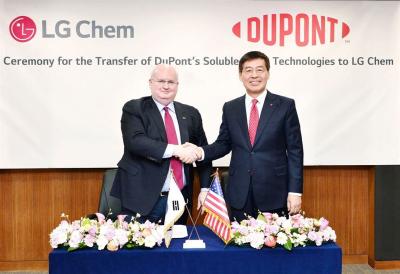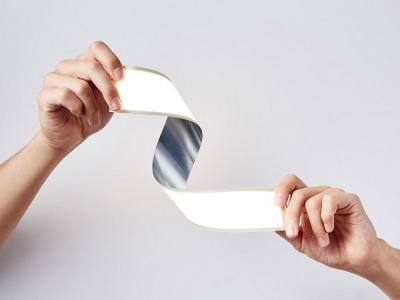LG ordered to compensate two Australian consumers due to OLED TV burn-in
A Federal Court in Australia ordered LG Electronics to pay a fine of $160,000 AUD to two consumers after LG refused to repair, replace or refund OLED TVs that exhibited burn in after less than a year of use.

Under the Australian law, consumers who purchased faulty products are entitled to a repair, refund or replacement - even if the warranty does not apply or has come to an end. The two OLED TVs were bought in 2013.
LG Chem and Universal Display to co-develop OLED host materials
In August 2019 Universal Display announced that it has established a network of OLED materials partnerships to help commercialize its new host materials. LG Chem announced today that it joined UDC's network and the two companies will work together to co-develop OLED host materials.

Under the new agreement, UDC will supply LG Chem with its phosphorescent emitters, while LG Chem will develop and host materials. The two companies will jointly develop the host/emitter system with an aim to develop a wider color gamut OLED device.
LG Chem acquires DuPont's soluble OLED IP and technologies
LG Chem has acquired DuPont's soluble OLED technologies and assets, in a deal estimated at $175 million. LG Chem will receive DuPont's entire soluble OLED IP (540 materials and process patents) and all of DuPont's related equipment and R&D facilities. The deal does not include any assets related to Dupont's evaporation OLED business.

LG Chem believes that the OLED industry is moving towards ink-jet printing of OLED panels based on soluble OLED materials and technologies - and it has now acquired key technologies in this area. DuPont has been developing related materials for over 20 years, has been collaborating with equipment makers (such as Kateeva) and display makers and has also developed its own nozzle-printing process.
DSCC: the OLED circular polarizer will reach $1.27 billion in 2022
DSCC says that the OLED circular polarizer market is set to grow from $428 million in 2017 to $1.27 billion in 2022. The market is still dominated by mobile displays.

The OLED circular polarizer market is led by two companies, Sumitomo Chemical and Nitto Denko, with LG Chem increasing its market share in OLED TVs polarizers.
DSCC lowers its OLED material revenue forecasts, published Samsung's latest OLED stack
DSCC lowered its OLED material revenue forecasts, saying that the market is expected to grow at a 25% CAGR from $773 million in 2017 to $2.35 billion in 2022 (down from its previous estimates of $2.56 billion in 2022). The fastest growing (51% CAGR) OLED application will be OLED lighting, which will grow from $12 million in 2017 to $95 million in 2022.

DSCC also published the material stack for Samsung's latest OLEDs (used in the Galaxy S9), which you can see above.
IHS: AMOLED production capacity set to grow over 300% in the next 5 years
IHS Markit says that global AMOLED production capacity is set to grow from 11.9 million square meters to 50.1 million sqm in 2022 - that's a 320% growth in 5 years. Samsung and LGD will remain the market leaders and Korea will have a market share of 71% in 2022 (down from 93% in 2017). China-based OLED makers will have a market share of 26% in 2022 (up from 5% in 2017).

IHS says that the majority of OLED capacity will still be used to produce RGB (direct-emission) OLEDs in 2022. RGB OLED production capacity will grow from 8.9 million sqm in 2017 to 31.9 million sqm in 2022. WOLED (WRGB) OLED TV panel capacity will grow from 3 million sqm in 2017 to 18.2 million sqm in 2022.
Idemitsu Kosan and LG Chem to share OLED material patents
Idemitsu Kosan and LG Chem announced a new collaboration agreement that will allow both companies to use each other OLED material-related patents in certain areas.

Idemitsu and LG Chem hope that this collaboration and patent sharing agreement will accelerate the development of new high-performance OLED materials. Through this cooperative arrangement, both companies will strongly support the OLED business of LG Display - but will also offer the outcome of this collaboration to other display companies.
Apple to invest in LG Display's OLED business to secure capacity?
The Korea Herald reports that Apple is in talks with LG Display to invest 2-3 trillion Won ($1.7-$2.6 billion USD) in LG's OLED production lines, in order to exclusively reserve some of LG's flexible OLED capacity.

The report says that the two firms already agreed on these investment plans, but the details (which includes the investment size and timing) have not been finalized yet. A couple of month ago we heard reports (originating from another Korean news outlet, Business Korea) that LGD is in talks with Apple.
UBI: the OLED emitter material market grew 17% in 2015 as producers increase capacity and change material suppliers
According to UBI Research, the market for OLED emitting materials grew 17% from 2014 to 2015. Universal Display (the top supplier in terms of revenues), Dow Chemical and LG Chem saw a decrease in sales while Novaled, Idemitsu Kosan and Samsung SDI saw improved revenues.

Samsung Display is the largest OLED producer by far, and so when it changes suppliers it changes the whole market. UBI says that in 2015 Idemitsu Kosan, the second supplier in terms of revenue started delivering blue fluorescent emitters to Samsung Display, and also enjoyed the ramp-up in OLED TV production by LGD.
LGD to soon decide whether to construct a Gen-5 OLED lighting fab
In October 2015, LG Chem announced that it has sold its OLED lighting business to LG Display, for $135 million USD, and the deal was finalized towards the end of 2015.

LG decided to consolidate all OLED production under LG Display - which will hopefully enable LG to advance OLED lighting more quickly - and at a lower cost. LG Chem has been discussing a Gen-5 OLED lighting production line since 2012, and the before the merger the company had plans to construct a new $185 million production line for OLED lighting by 2017.
Pagination
- Previous page
- Page 2
- Next page

